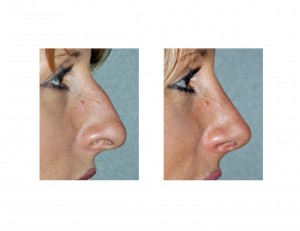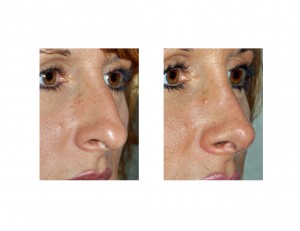Background: Noses have an incredible variety of shapes and are the most diverse and complex structural feature of the face. With over a dozen different anatomic facets to them, it is no wonder how different one’s nose is from another. But despite this structural diversity, there are several features of a nose that are associated with good aesthetics and desireable proportions. A straight dorsal line, a nasolabial angle of 90 to 100 degrees and a tip that is fairly narrow are the foundations of an aesthetically pleasing nose.
There are some common aesthetic deformities of the nose that many people have. A dorsal hump or bump, a low hanging tip (nasoloabial angle less than 90 degrees) and a wide or fat tip are all common patient concerns. But when they are all grouped together, they create a classic appearing nose deformity that some patient’s refer to as a ‘witch’s nose’. While this is an extreme phrase to refer to a nose, it relates to one that has a dorsal hump, a low hanging tip and an overall profile convexity or curve to it. This is obviously a miniscule version of the nasal appearance of a classically depicted witch’s nose but the concept can be appreciated.
Case Study: This 37 year-old female wanted to change the shape of her nose which had bothered her since she was a teenager. She felt her nose was too big and looked like a ‘witch’s nose’. She didn’t like the hump in the upper half of the nose and felt the tip was too long and turned down. She particularly did not like the way her nose looked in the side view. She had no breathing problems through her nose.
In presurgical counseling, changes were made to her nose in photographs in the front, side and oblique views. Changes were made to determine whether she wanted a smooth or slight concavity to her dorsal profile and how much tip shortening and tip elevation she found was enough.


Case Highlights:
1) The ‘witch’s nose’ deformity is associated with any degree of a nasal hump and a down plunging tip.
2) The goal of rhinoplasty in the ‘witch’s nose’ is to remove the nasal hump and lift and shorten the nasal tip.
3) Open rhinoplasty allows the visibility to achieve a smooth dorsal line and a lifted but not over rotated nasal tip.
Dr. Barry Eppley
Indianapolis, Indiana


